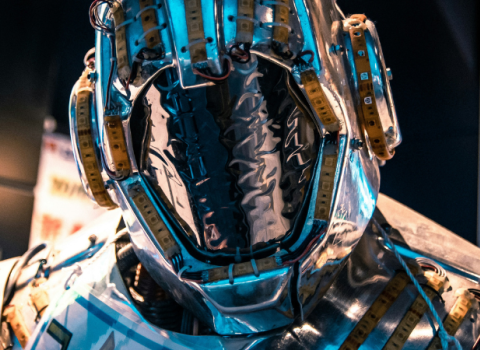Clothing that sucks drinking-water direct from the air is among the novelties that 1,400+ students have devised as part of ATTRACT Academy’s training for future tech entrepreneurs

The PuffAIR jacket, a prototype from the EU-funded ATTRACT project. Photo credit: ATTRACT
When Anna Cain, a masters’ student in Barcelona, was looking for inspiration for a school project, she was thinking about climate change – and how technology might help.
There was a severe drought underway that “was really bad where we were living in Barcelona,” she recalls; “so I think it was just at the top of my mind.” What if, she and some friends wondered, you could get water directly from the air?
So that’s what her team devised: A lightweight jacket that condenses water from the humidity in the air all around, then sterilises it so it’s ready to drink. To make it, they borrowed some fancy technology they encountered on a study-visit to CERN, the famed particle accelerator near Geneva. The result is a prototype – to be on display at a conference 2-3 July in Brussels for an EU project that funded her visit. Working on the jacket, which they call PuffAIR, taught her a lot. “I loved the experience,” she says. “It was the highlight of my master’s experience.”
Hands-on tech training
Hers was one of many student tech projects organised since 2018 by the EU-funded ATTRACT project, in an unusual teaching experiment. More than 1,400 students from universities across Europe have taken part. The goal: To provide hands-on training in tech entrepreneurship, something Europe needs more of if it’s to compete in global tech markets.
The main focus of the €55 million ATTRACT project is helping move “deep tech” innovations from lab to market, through a CERN-led consortium that includes seven big research institutions, a business organisation, and two universities: ESADE Business School in Barcelona and Aalto University in Helsinki. But studying innovation and teaching young entrepreneurs are also among ATTRACT’s objectives.
The curriculum for what ATTRACT calls its Academy involves a 12-week programme devised by ESADE and Aalto with help from other universities. The students come from all disciplines: engineering, physics, business, finance, marketing, design – some 75 specialties in all. At their home universities, they attend classes on the key skills a flexible, multi-skilled innovator will need. Then they travel to meet the technology and its inventors — often to Geneva and CERN’s IdeaSquare innovation centre. In teams, they brainstorm on possible applications. Then they protype, draft a business plan or develop marketing strategies.
In the PuffAIR project, the team was developing what it called “functional fashion to ensure survival in the climate crisis era.” At the time, Cain, a student at the Fabricademy textile and technology programme, had been reading a book about biomimicry – that is, turning to nature to find solutions to human problems. That led the team to look at an odd beetle that survives in the arid Namib Desert on the west coast of Africa by collecting water droplets on its bumpy back during morning fog and somehow getting the moisture to roll down into its mouth.
Between the beetle and the drought, Cain recalls, “I think we just put those two thing together, and we thought, ‘let’s focus on water,’ because everybody’s talking about it and we are experiencing it every day where we are.” The project also drew some inspiration from the film, Dune, “just because of how sci-fi the project kind of is,” she says. Her team also included an Argentine student, Julia Rodriguez Heine, and Nico Garare of Spain who contributed much to the jacket’s functional fashion design. “He had a lot of the vision for the physical prototype we were going to create,” Cain says.
In that prototype, a fan blows the surrounding air into the jacket made from a special fabric created on a computer-controlled knitting machine called Knitterate, That condenses the humidity into water that falls into a pouch. There, it is sterilised by a new carbon-based graphene system, under development by an ATTRACT R&D project called Megamorph, that generates ultraviolet light. A water-purity sensor double-checks it – ready for drinking. Cain recalls her favorite moments as the opportunities she had to make presentations about the jacket. That helped with her public speaking confidence, and with the ability to translate her ideas into concrete thoughts. An American still living in Barcelona, she currently works on digital marketing for an organisation that promotes global standards for organically made textiles.
While the prototype could be a product one day, she says, “we didn’t really take a business approach from the start.” Instead, they wanted to make a statement: use the jacket as a launching point for a conversation or for ideas for design in the future. “It was an exploration of how we could be thinkers and dreamers.”
Some of the other student prototypes, also on display at the Brussels conference:
CSOIL -- Soil monitoring solutions for climate change
“Know Your Soil,” the students’ slogan, urges farmers to continuously monitor their soil quality. This compact, portable, affordable soil reader could help farmers alleviate problems related to climate change. It was inspired by United Nations Sustainable Development Goal 15: Life on Land, which states: “Soil degradation affects nearly one-third of the Earth’s land area, impacting food security for billions.” It’s based on the ATTRACT project, AHEAD: technology to print specialised 3D sensors inside tubes and piping, for in situ sensing, heating and energy harvesting.
Farmers plant the CSOIL device, a metal tube with sensors powered by solar cells, in the ground with the same machinery they use to plant their seedlings. It stays in the soil year-round, measuring what’s in the water moving through the surrounding soil. It can be easily located in the field by its solar panel, which doubles as a marker flag. As well as the resulting soil information, farmers receive care consultations via mobile applications.
HIPMED Bracelet – Relief for blood cancer patients
This prototype, based on a student project called RBA for Rapid Blood Analysis, could help blood cancer patients manage some of the invasive, time-consuming and emotionally challenging treatments they can encounter. RBA is a bracelet, much like a smart watch. It has special “hyperspectral” sensors, developed by the HIPMED ATTRACT project, that can see and measure components in blood passing through the wearer’s wrist. It transmits its 3D images of the data to an artificial intelligence system for analysis – including identifying cancer cells. That way, it provides continuous monitoring of a patient’s blood, reducing the need for frequent blood draws. Further, it can store medication for absorption through the patient’s skin in correct doses.
Unlike most of the other student prototypes, there are plans afoot to develop this one further and bring it to market by 2030.
LUMO – Improving outcomes for rural cancer patients
A distressing fact: people in rural regions can face higher death rates from cancer than those in cities – simply because they live far from big hospitals and their expensive imaging equipment.
This cylinder-shaped device, LUMO, is a hand-held, cheaper way for clinicians in the countryside to get a quick imaging scan for cancer patients. Based on a novel imaging technology developed by the ATTRACT POSICS-2 project, the LUMO could reduce the time needed to detect a change in a patient’s cancer. With it, local doctors would be able to make more precise and rapid decisions, and patients’ waiting time from check-up to results will go down by as much as 60%. That can reduce stress for rural cancer patients and improve outcomes.
TumorDeTech - Real-time cancer monitoring
This project aims at transforming cancer research and treatment through predicting tumour growth more accurately.
This device incorporates technologies from two different ATTRACT projects: the imaging and scanning technology from POSICS-2, and a quantum-number generator from the RandomPower project to ensure hacker-proof encryption. The prototype device can efficiently detect even very small, early-stage tumors, as little as three millimetres in radius, in a few seconds and also deep into the tissue. That allows for precise, real-time tumour monitoring. With the device, the group envisions clinics sharing tumour data – encrypted to ensure privacy – to develop a global open-source algorithm to predict tumour growth.





 A unique international forum for public research organisations and companies to connect their external engagement with strategic interests around their R&D system.
A unique international forum for public research organisations and companies to connect their external engagement with strategic interests around their R&D system.